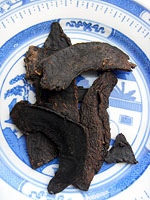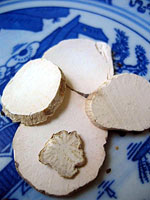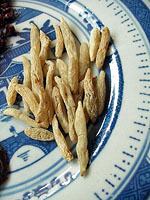|
Sweating too much may be embarrassing; however, a lack of perspiration can be a life-threatening problem. When the body stops sweating or does not perspire enough to cool itself, it can lead to overheating and vulnerability to heat-related diseases such as heat cramps, heat exhaustion and heatstroke.
Medically, little or no sweating is called anhidrosis. This problem may occur over the entire body, in an area or scattered patches of the body surface. It can develop on its own, or as a sign of other health problems. There are many causes for little or no perspiration, including:
 |
certain medications, such as antipsychotics and diuretics |
 |
neurologic control problems |
 |
skin damage leading to obstruction, atrophy or degeneration of sweat glands |
 |
serious dehydration |
 |
congenital absence of sweat glands |
Mild cases of anhidrosis tend to go unrecognized. Sometimes, localized anhidrosis provokes compensatory excessive sweating in other parts of the body which may become the patient's main complaint. Treatment of anhidrosis usually focuses on the underlying cause, but there are some cases where the reason remains unknown.
In traditional Chinese medicine (TCM), normal sweating relies on three factors:
 |
Proper material basis for sweat production |
 |
Sufficient qi to motivate the sweating process |
 |
Skin pores that can open and close freely |
TCM approaches to promote sweating are:
 |
Removing pathogens that accumulate on the body's surface so as to unblock the skin pores: commonly used herbs are green onion stalk, fermented soybean, ephedra, schizonepeta herb, ledebouriella root and ginger. |
 |
Replenishing qi and regulating the lung to smooth the sweating process: commonly used herbs are astragalus root, pilose asiabell root, ginseng, liquorice root, platycodon root, cassia twig and aconite root. |
 |
Enriching essence, blood or body fluids to ensure the source of sweat production: commonly used herbs are angelica root, rehmannia root, white peony root, dwarf lily-turf tuber, figwort root and snakegourd root. |
 |
|
 |
|
 |
| figwort root |
|
snakegourd root |
|
dwarf lily-turf tuber |
As people with anhidrosis cannot dissipate body heat efficiently, they may easily experience skin that is red and hot to the touch, fatigue, palpitations, dryness, thirst, constipation, urinary difficulty and irritability. TCM physicians will group symptoms together and design a remedy according to the disharmony pattern.
Exhaustion of yin and fluids
Exhaustion of yin and body fluids is manifested by little or no sweating, burning skin or excessive feverish sensation inside the body, mouth dryness, red cheeks, warm in palm of hands and soles of the feet, dry stools, breath shortness, general weakness, fatigue and numbness in the limbs. The tongue is red without any coating and the pulse is thready and rapid. The remedy should nourish yin, promote fluid production, regulate the internal environment and harmonize fluid distribution.
Sample prescription: Cinnamon Twig Decoction combined with Increase the Fluids Decoction plus snakegourd root, dendrobium, fragrant Solomonseal rhizome and coastal glehnia root.
Deficiency of yang qi
Deficiency of yang qi is manifested by little or no sweating, limb coldness, sensitivity to low temperatures, lumbar soreness, and general weakness. The tongue is pale and the pulse is weak. The remedy should support yang, replenish qi, regulate the internal environment and unblock the skin pores.
Sample prescription: Modified Regeneration Powder
Coldness block the skin pores
This refers to a sudden loss of perspiration, little or no sweating for a short period of time. Other related symptoms include getting goose bumps or skin itchiness, sensitive to low temperatures, while the tongue looks pale and the pulse is tense. The remedy should expel coldness, reopen the skin pores, and promote the movement of yang qi to the body surface.
Sample prescription: Half Ephedra and Half Cassia Twig Decoction
Congenital essence deficiency
This refers to congenital absence of the sweat glands. Individuals also present with dry withered skin, sparse body hair, and deformed nails and teeth. There are cracks on the tongue surface and the pulse is thready, rapid and weak. The remedy should reinforce the kidney, replenish essence, harmonize the blood and regulate the internal environment. Suggested herbs for the prescription: click here
No sweating in an area of the body surface such as that occurs after stroke is usually due to blood and qi stagnated in the localize meridians. Acupuncture and moxibustion should be used along with oral treatment, which can restore the normal sweating by dissolving the blood stasis, and activating the meridian flow.
In order to prevent complications associated with little or no sweating, it is essential to keep hydrated especially in summer. People should drink fluids before, during and after engaging in exercise. They should also wear loose light clothing to help the body stay cool.
When there is prickly heat, herbal powders may provide relief. Prepare soapstone (54g), liquorice root (6g), processed alum (15g) and borneol crystal (2g). Pound the ingredients until they are reduced to a fine powder and put aside. Wipe the body with a wet towel first, lightly dust powder and rub in. Do this as necessary.
It is also recommended to eat more foods that allow the elimination of body heat through urination. Such foods include bitter gourd, watermelon, strawberries, tomatoes, mung beans, cucumber, wax gourd, lotus root, lotus seed, lotus leaf, coix seed, red rice bean, bean curb, water chestnut, bean sprouts, duck and fish. In general, the daily diet should contain plenty of vegetables and fruit as these provide adequate fluids. Foods that can increase the lubricating or moist nature of the body fluids include animal organs, lily bulb, Chinese yam, white fungus, Chinese wolfberry fruit, coastal glehnia root and carrots. |